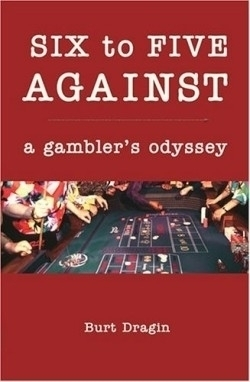Six to Five Against
A Gambler's Odyssey
“The best throw of the dice is to throw them away,” says an English proverb, and it’s a good one-line summary of the advice that this book offers to the compulsive gambler. But this is no moralistic treatise against making bets. Rather, this is part memoir, part scholarly discourse—an earnest exploration of the nature of addiction, written by an author who has himself struggled against the siren’s call of casinos and racetracks throughout his adult life.
By way of excavating his personal experience, Dragin begins by reaching back in time, to Cleveland during the late 1920s, where his father spent his late teens surrounded by street toughs, gangsters, and two-bit hustlers. It was a world that valued action more than thought, put a premium on the “big score,” and implied that the cautious man was a bore, if not a sucker. Dragin’s father would carry some part of this mentality for the rest of his life, never quite finding anything to replace the gambling high, and he would pass it on, perhaps somewhat diluted, to his son.
Though father and son share the gambler’s obsession, the author, unlike his father, is equally drawn by his love of stories, knowledge, and contemplation. In addition to being a compulsive gambler, he is a freelance writer, published in various newspapers and magazines, and an instructor of college journalism, which gives him the ability to analyze his life with a kind of honesty that his father—like many pathological gamblers—could never muster. During a guest lecture on “dice and probability” in a friend’s algebra class, Dragin finds himself getting excited sharing his knowledge with the students. “Talking passionately about gambling seemed to satisfy some level of my craving for casino action,” he writes. “It hadn’t occurred to me then that scouring gambling addiction literature might have the same salutary effect.”
This experience plants the seed that eventually grows into this book, by introducing the notion that it might be possible to understand the compulsion to gamble by thinking and writing about it. When Dragin gets around to exploring the nature of gambling in earnest, he journeys from Freud to modern-day neuro-psychology, from Dostoevsky (himself a notorious gambler) to Moby Dick, from cutting-edge genetics research to Gamblers Anonymous case studies.
It all adds up to a compelling story. Dragin deftly weaves the various strands of personal experience, philosophical musing, and scholarly analysis into a fine narrative tapestry. At a few points, especially in “Part 3: Profiles,” the story veers into repetition, but this is a minor flaw. Anyone who is curious about addiction, those who have a passion for well-wrought nonfiction, and most especially gambling addicts and their loved ones, who desperately want the dice to be thrown away, should read this book.
Disclosure: This article is not an endorsement, but a review. The publisher of this book provided free copies of the book to have their book reviewed by a professional reviewer. No fee was paid by the publisher for this review. Foreword Reviews only recommends books that we love. Foreword Magazine, Inc. is disclosing this in accordance with the Federal Trade Commission’s 16 CFR, Part 255.

